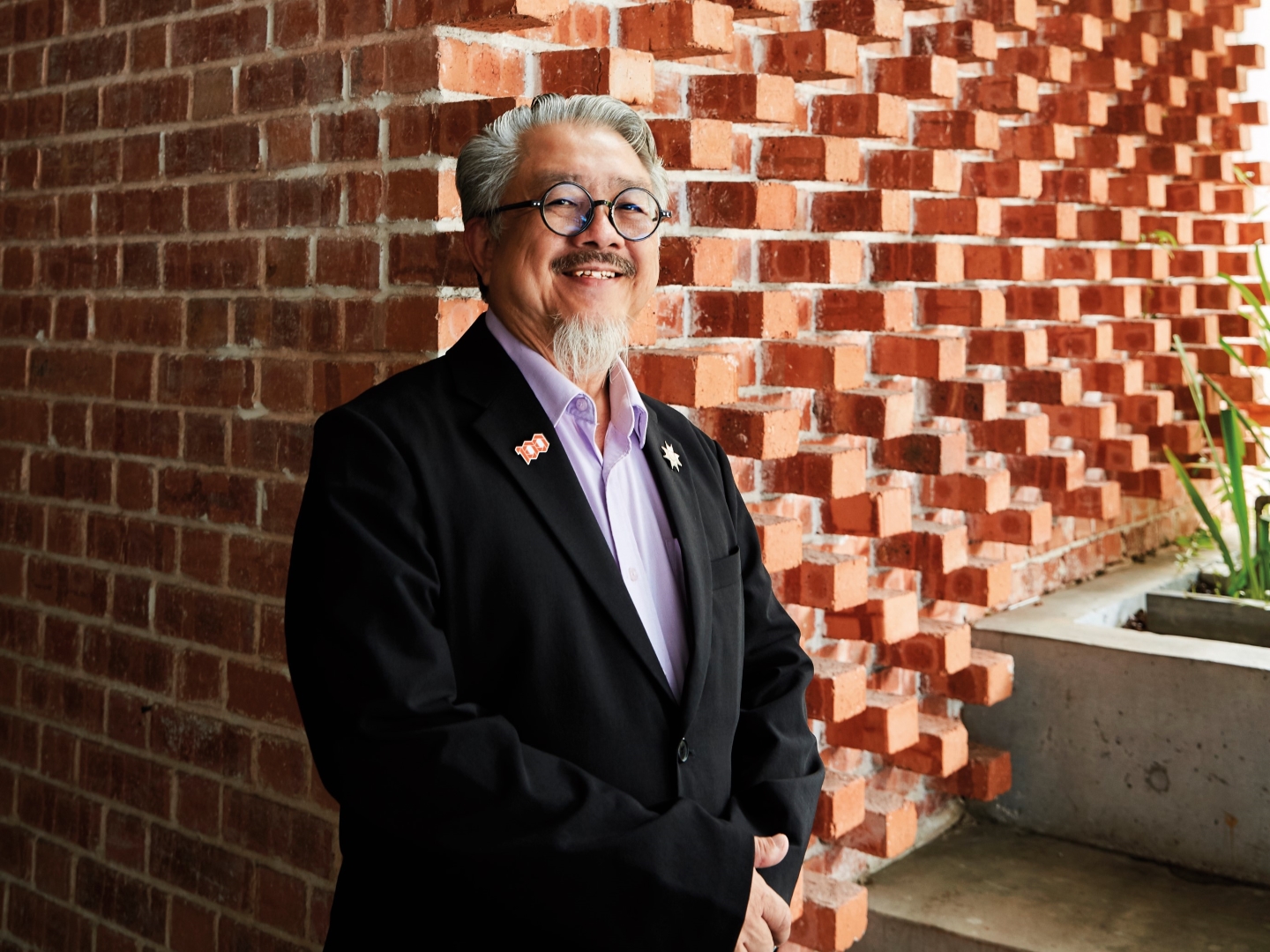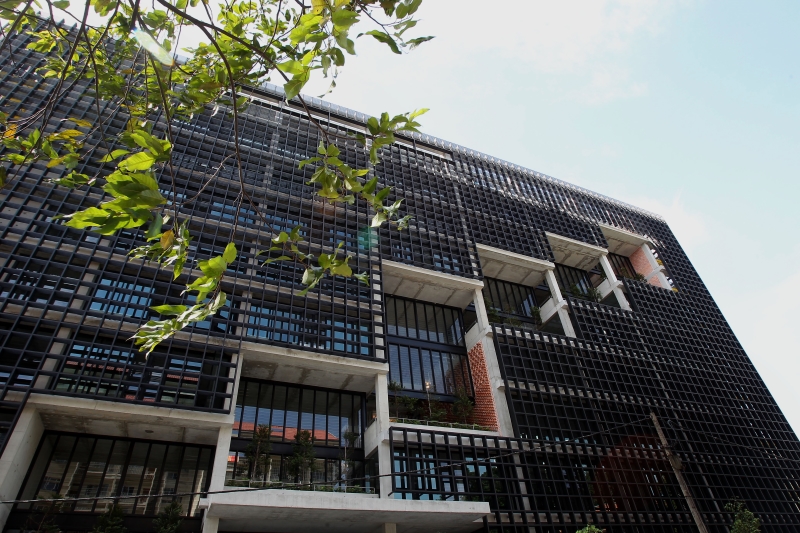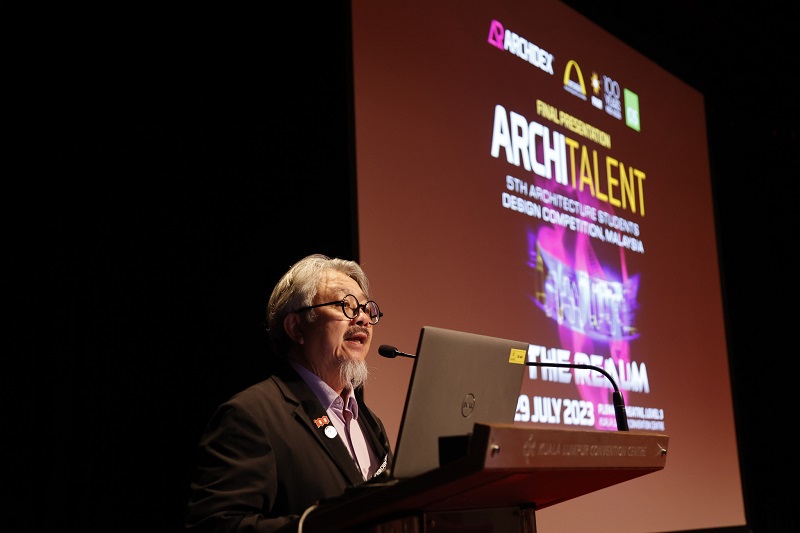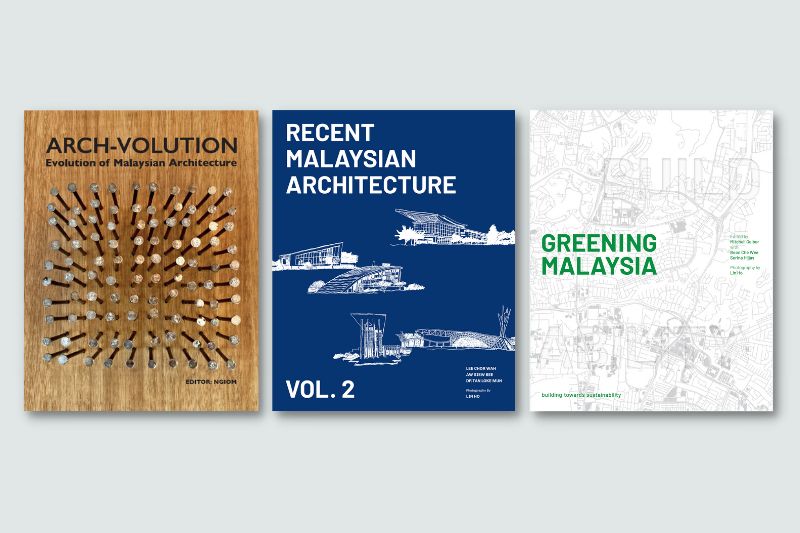
Abu Zarim says a special committee is in charge of 100 programmes to mark this significant anniversary and he lauds the effort (Photo: SooPhye)
Imposing and inviting. These words come to mind as you approach the PAM Centre from the road and walk up to the second floor, where you immediately get a feel of what good architectural design can do. No surprise, then, that Pertubuhan Akitek Malaysia president Abu Zarim Abu Bakar suddenly turns proud host, pointing out the winning features of the 10-storey building during a recent visit.
“You can see how we get a sweeping flow of air here. It is purposely designed that way so we consume less energy to cool the building. The focus is on the utility spaces, the open areas for members to just come and use,” he begins, obviously at home in the Malaysian Institute of Architects’ headquarters in Bangsar, Kuala Lumpur.
A shear wall with ventilation holes adjoining a straight staircase leads to the top of the Green Building Index Platinum-rated structure. A black aluminium façade, high ceilings, skylights, louvre windows, exposed brick walls and a diagonal stack of atriums allow air and natural light in, enhancing the welcoming vibes.
“It’s a utilitarian sort of building,” says Abu Zarim. It is an ideal place, one may add, to bring members together and promote the activities he has in mind for PAM, which turns 100 this year.
A centenary is a milestone that could trigger lavish ideas for a big bash. But coming into office in May and still mindful of the havoc wreaked by Covid, he is focused on recovery. “Some people lost projects or staff as a result of cutbacks. I said to my members, ‘I just want to do more for you guys.’ So, I have instituted very simple programmes they can benefit from.”
It is a pledge that goes from heart to hand and which PAM’s 5,000-strong membership, comprising corporates, graduates, academics and students, would appreciate and applaud.
Abu Zarim introduced a committee to help members navigate digital innovation and technology, a crucial move, seeing how work transitioned online during the lockdowns. Noticing that the institute’s Southern chapter had begun digitising time-consuming manual processes, such as keying in attendance or streamlining routine processes, he asked its chairman to “please come and do it for the whole of PAM and architects in Malaysia”.
Subsequently, there were talks on artificial intelligence and using digital and innovative methods at work. These sessions are like training programmes for members to gain new skill sets, which fall into place with his plans.
20160719_bld_pam_1688_izw.jpg

“The aim is to close the gap for those who are behind on new ways of doing things and bring them up to par with the rest of the industry,” says Abu Zarim, who admits he is far from tech-savvy. “It’s not because they lack interest. Digitisation is basically something we need to fathom. It takes time to do that.”
Time is at a premium for PAM presidents, who have just one year to carry out their plans, and justify why. Four times over almost 15 years, he had proposed a two-year term for those elected to the top, but members said no. Will he put his name up to serve a second year?
“I have to wait and see. I’m trying my best to make sure I do what I promised in the short period of time I have. A lot of my friends say, ‘Now that we’re celebrating 100 years, why don’t you plan for the next 100?
“I say, I don’t have 100 years. I only have one year. So, I’ve kept it simple. Many of our members lost their jobs and fell into hardship. We’re trying to get these people out of the woods in whatever way we can, and do stuff that is more meaningful for them.
“People took to doing Grab delivery, driving taxis or going off the grid altogether — they went into social media, which they find a lot easier and more fun. Of course, we are sad to see them go because the training of an architect takes such a long time.”
PAM was founded in 1923 as the Institute of Architects Malaya, before changing its name in 1948 to the Federation of Malaya Society of Architects, then allied to the Royal Institute of British Architects. When PAM was registered with the Registrar of Societies Malaysia on Jan 20, 1967, it assumed its present name. What has not changed is its mission to “promote the advancement of architecture and the architectural profession for the betterment of society”.
Going back to its 100th anniversary, regular events on the institute’s calendar have come under its birthday banner this year. Celebrations kicked off in January with the launch of the Kuala Lumpur Architecture Festival 2023, which has programmes spread throughout the year. They are divided into five key thrusts — Engage, Educate, Evolve, Extend and Evoke — wrapped around KLAF’s theme “NEXT100”.
One event rolled out at the festival earlier this year was a marker competition that invited members to submit an entry that would be permanently displayed at the PAM Centre, in conjunction with its centennial. The work could be a sculpture, painting, relic, plaque, mural or even a symbol, as long as it is installable.
Another competition, 40 Under 40, turns the spotlight on Malaysian architecture and the next generation of architects poised to push the boundaries of design and innovation. It was open to graduate architects under the age of 40, who had to submit two completed works and three design works to convince the panel they have it in them to shape future living and working environments.
Exploring the unknown was what competitors had to do for two other events under KLAF2023, which concluded in June. The Future Practice Competition challenged architects, graduates and students to rethink the ideal architectural practice while the PAM Metaverse Competition had participants design an immersive metaverse for the institute.
Archidex, a yearly exhibition jointly organised by PAM and various partners, brings architecture, interior design and the building industry under one roof. Held from July 26 to 29, it attracted close to 90% of 2019’s visitor numbers, a healthy sign for the institute’s main money-earner.
During the same period as the festival, there was PAM’s annual conference, Datum 2023, whose theme, We As 1, loops to the notion that the practice of architecture is inclusive. Datum asked pertinent questions — How do we create and shape the space we share, our city? How do we make the most of what we have in common, and explore the things we don’t? — to learn ways to build better and stronger links for the next 100 years.
Abu Zarim says a special committee is in charge of 100 programmes to mark this significant anniversary and he lauds the effort. “It’s quite an achievement and we’re close to about half that number now.” The year-long celebration will culminate in a gala dinner to be held at The Majestic Hotel Kuala Lumpur on Oct 21.
Quieter but equally meaningful events on PAM’s calendar include visits to schools, where professionals share insights and experiences with students who aspire to join the profession. Joy of Creating and Building is an on-going initiative that engages schoolchildren, who get to experience the process of design and construction hands-on, thereby making them think about sustainability and how architecture impacts the environment.
There is also the coveted PAM Architecture Awards, run totally online starting this year, making it more affordable to enter and friendlier to the environment. There are multiple categories of competition (14 for 2023) and the panel considers all types of buildings that highlight the work of architects, clients/owners, builders and contractors who strive to design architecture that stands the test of time.
A sole proprietor who does small jobs, which can be as simple as renovating a house or a single-storey landed unit, can submit his work for consideration, Abu Zarim emphasises. “I keep saying to people, let’s make heroes of our members. Because, if we don’t do it, who will?”
On the flip side, there is the undercutting. It happens and is unhealthy, but on the whole, most PAM members would follow the recommended fees and tell clients who negotiate prices to go to someone else, he notes. “I would say a high percentage of our clients are very, very responsible. And these are the people we are looking for.”
archidex.jpg

With big projects becoming more common, he thinks it is practical and beneficial for architects to work together, with each handling different blocks or areas. “We keep telling our members, if you are small, it’s very difficult for you to grow. If possible, talk to your friends and collaborate with each other,” he suggests.
“Gone are the days of the super architect, though I wouldn’t say they are a dying breed. Now, you can see a lot of huge projects. It has become the practice, not the architect, that shines.”
It is not uncommon for architecture students to drop out halfway, a key reason being the many years it takes to complete the course. Abu Zarim shares the findings of a study that might make one think twice about quitting. According to the study, if one were to pursue architecture in totality, with its many branches, it would take 23 years to gather enough knowledge and skills to practise. However, a bachelor’s degree in architecture typically takes five years to complete.
“The rest is basically down to your interests and passion to pursue the branch of architecture you choose. There are so many, from conservation to technology to academics to social architecture. Some take administration very seriously, some like contracts, some go into writing,” he says.
“I’m still in my practice, but I find myself drawn to teaching part-time, giving back to students what I’ve learnt over time. I don’t like writing, which is a shame because there’s plenty to talk about. I think I have one or two books in me, basically on practice. It is so varied that you can write almost anything, depending on what you have gone through.”
Abu Zarim’s own experience ranges from being asked to design a two-storey building to master-planning two townships, in Bandar Rinching, Selangor, and Bandar Seremban Selatan in Negeri Sembilan, comprising a total of almost 10,000 residential units. “I’m still a sole proprietor, so these are already good enough for me to say, ‘Yeah, I’ve done something’.”
Projects are sometimes a matter of opportunity and luck, he adds, because something unexpected, such as a land issue, could prevent things from working out the way you want.
Things have panned out well for Abu Zarim, who eagerly shares what made him choose architecture in the first place.
“When I was about 10, somebody asked me what I wanted to become. At that point in time, you’d probably just say a policeman or whatever. Somehow, one person said, ‘Why don’t you become an architect?’ I didn’t know what that was, but [the idea] sort of stayed with me. When I was in Form Four or Five, I had done some research and being an architect stuck in my mind.”
When it came time to apply for a place at Institut Teknologi Mara (now Universiti Teknologi Mara), he wrote architecture as his first, second, third and fourth choice. He was accepted, did four years at ITM and worked for about eight months.
pam_books.jpg

Abu Zarim was then offered a scholarship to continue the second part of his architecture studies in Australia. “I turned it down. When they asked me why, I said I wanted to go to the UK because, from there, I could go to Europe and see a lot more stuff.
“They said okay, but instead of a scholarship they would give me a loan. So, I took it, went there and ended up spending almost 10 years in the UK. When I graduated, Malaysia was facing bad times and my father said to get some work experience before coming back.”
Abu Zarim worked for two architectural firms in London — Llewelyn-Davies Weeks and Clifford Tee + Gale — before returning home in 1991 with his wife. A year later, he set up AZ Rekatelier and has since chalked up more than 30 years’ experience in commercial, residential, condominium and institutional developments.
In the May 2023 issue of Berita Akitek, he reminisces about joining PAM in 1992, being elected to its council in 2002, serving quietly in the background and facing challenges along the way in various capacities before succeeding Sarly Adre Sarkum as president in April this year. He talks about taking up matters close to PAM members’ hearts, especially practice issues, getting more of them to represent the institute in local authorities and agencies to voice critical matters affecting the profession, and encouraging them to use PAM as a platform to promote their practice.
Next year, there will be a lot more opportunities to put PAM on the world map when it hosts the Union Internationale des Architectes (UIA) International Forum. PAM, together with the Malaysian Convention & Exhibition Bureau, won the bid for that honour at UIA’s extraordinary general assembly in Madrid last year.
Themed “Diversecity: Humanity and Sustainable Growth”, the forum will examine how emerging economies and growing cities can achieve those two targets. Three sub-themes — Culture and Heritage, Density and Sustainable Growth, and Equity and Ecology — will drive discussion, dialogue, workshops and programmes centred on the identity base of cities, the vision of a future mega-city and the next frontier of urbanism.
Founded in 1948, Paris-based UIA is a federation of national professional organisations working to unify architects, influence public policies and advance architecture to serve society’s needs.
PAM’s selection as host was years of hard work coming to fruition, says Abu Zarim, who was with PAM delegates at the UIA Congress in Copenhagen some weeks ago to promote the UIA International Forum 2024 and what Malaysia has to offer participants: diverse architecture, Unesco World Heritage Sites, forests, beaches and hills, wildlife, flora, multicultural festivities and traditions, gourmet restaurants, street food and delightful local fare. Plus, of course, the Petronas Twin Towers and Merdeka 118. There will be technical visits to the latter, the world’s second-tallest building, for selected forum participants.
He is pleased with the feedback from the people they spoke to in Denmark — “many said they would come, in numbers” — and is quietly confident of bringing in thousands to the event, of which maybe half the number will be from the international arena. “But we cannot rest on our laurels. We have to keep pushing.”
The call for papers is out and various invited speakers have confirmed their participation. Bearing in mind the wide scope of “Diversecity”, Abu Zarim looks forward to a range of topics being covered at the forum. Everyone is welcome to take the podium, be they architects, town planners, engineers, scholars, policymakers or stakeholders, he adds. “If something is interesting enough, please come and talk.” Another simple invitation from the president, for the greater good of PAM and its members.
This article first appeared on July 31, 2023 in The Edge Malaysia.


